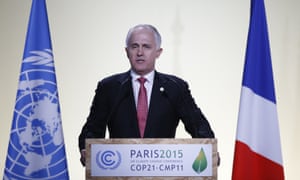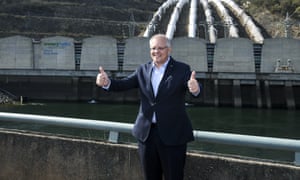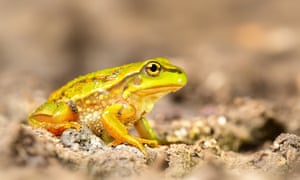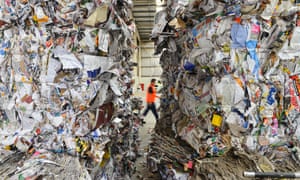Extract from The Guardian
With the global and local environment at crisis point, Australians
have a clear choice at Saturday’s election. Here are the parties’ key
policies
This has been called the climate change election, and with good
reason: concern about the climate and environment has never been
greater.
A Lowy Institute poll found nearly two out of three adults believe climate change is the most serious threat to Australia’s national interests, an 18-point-increase in five years. It was taken before a landmark UN global assessment defined the extent of the unprecedented biodiversity crisis facing the planet, with a million species at risk of extinction and potentially dire consequences for human society.
Australia has a big stake in these issues. It is one of the world’s top greenhouse gas emitters on a per-capita basis and in the top 20 for total pollution, with a footprint greater than Britain or France. It is already experiencing the effects of climate change, including increased heatwaves and mass coral bleaching on the Great Barrier Reef, and is the global leader in mammal extinction.
There are clear choices between the parties on these issues at this election. Guardian Australia looks at how the policies of the Coalition, Labor and the Greens line up.
Coalition
Under the Paris climate deal, the Coalition says it will cut emissions to 26% less than they were in 2005 by 2030. It is significantly less than what scientists advising the government say is necessary for Australia to play its part in meeting the goals of the Paris deal (a 45%-63% cut by 2030 compared with 2005).
Scott Morrison explained in February how he planned to meet this goal.
About eight points of the cut would come from using what are known as
Kyoto carry-over credits. Unlike international and domestic carbon
credits created through offset projects, Kyoto carry-over credits do not
represent an actual reduction in carbon dioxide. They are bonus credits
that Australia wants to award itself for beating the low 2020 target it
set itself. It would just mean counting the same emissions cut twice.
It is unclear if they will be allowed under the Paris deal; almost all other developed countries have said they will not use them. Developing countries do not have the option.A Lowy Institute poll found nearly two out of three adults believe climate change is the most serious threat to Australia’s national interests, an 18-point-increase in five years. It was taken before a landmark UN global assessment defined the extent of the unprecedented biodiversity crisis facing the planet, with a million species at risk of extinction and potentially dire consequences for human society.
Australia has a big stake in these issues. It is one of the world’s top greenhouse gas emitters on a per-capita basis and in the top 20 for total pollution, with a footprint greater than Britain or France. It is already experiencing the effects of climate change, including increased heatwaves and mass coral bleaching on the Great Barrier Reef, and is the global leader in mammal extinction.
There are clear choices between the parties on these issues at this election. Guardian Australia looks at how the policies of the Coalition, Labor and the Greens line up.
Emissions
Carbon pollution in Australia has been rising since the Coalition repealed carbon price laws in 2014. The country is on track to meet its modest Kyoto protocol target – that emissions be 5% lower in 2020 than in 2000 – but not 2030 targets.Coalition
Under the Paris climate deal, the Coalition says it will cut emissions to 26% less than they were in 2005 by 2030. It is significantly less than what scientists advising the government say is necessary for Australia to play its part in meeting the goals of the Paris deal (a 45%-63% cut by 2030 compared with 2005).

The biggest flaw is in the administration of the other half of the direct action program, known as the safeguard mechanism. It was supposed to put a limit on industrial emissions to ensure they did not just wipe out the cuts taxpayers are buying through the emissions reduction fund, but in practice industrial emitters have mostly been allowed to increase pollution without penalty. The Coalition has criticised Labor for planning to use the safeguard mechanism to do what government frontbencher Greg Hunt designed it to do: reduce emissions.
The other major measure on the Coalition’s carbon budget chart (see p8) is “technological improvements”, which have not been explained.
An analysis by scientists from Climate Analytics released on Friday found the Coalition’s target was insufficient to deal with the climate challenge and said there was no evidence the government planned to release further policies.
Labor
Labor has a more ambitious emissions target: a 45% cut by 2030, which Climate Analytics says falls just within what is necessary for Australia to play its part in limiting global warming to 1.5C, and net zero emissions by 2050. Rather than an across-the-board carbon price similar to what it introduced in 2011, it is promising different policies for different parts of the economy.

On electricity, it wants to bring in a national energy guarantee, a policy devised and abandoned by the Coalition. Similarly, for heavy industry, it plans to toughen up the government’s safeguard mechanism to set limits and reduce them over time. It is yet to say what the limits would be and the trajectory – how fast they would be cut – but it says both the electricity and industrial sectors will have to meet the 45% target.
It wants 50% of new cars to be electric by 2030 and has pledged vehicle emissions standards to limit transport pollution, building on work done under the Coalition but not adopted. It would boost the use of carbon offsets from Australia, allow business to buy an undefined amount from offsets from overseas and has suggested it would limit land clearing.
Despite some scary headlines about costs, Labor’s ambition and direction has been praised by policy analysts and scientists. But unanswered questions remain. It has not released a carbon budget explaining how it would hit the 45% target. And it has been accused of hypocrisy for a promise to spend $1.5bn to boost natural gas supply in Queensland and to connect the Northern Territory’s Beetaloo sub-basin to the east coast. Green groups say the emissions that result could dwarf those from Adani’s proposed Carmichael coalmine.
Speaking of which: Labor has struggled to articulate a position on the mine. Shorten has expressed personal reservations but not committed to either blocking or supporting it.
Greens
The Greens want emissions cut by between 63% and 82% by 2030 compared with 2005, and zero emissions by 2040. Their policies include ending fossil fuel subsidies, phasing out fossil fuel mining and electricity generation by 2030, vehicle emissions standards that become a ban on new petrol-fueled cars by 2030 and an economy-wide carbon price to reflect the true cost of pollution. A new public authority, Renew Australia, would lead the transition to low emissions.
Climate Analytics says the Greens’ goals sit well within what the scientific literature says would be Australia’s fair share of emissions cuts.
Renewable energy
CoalitionThe government does not have a renewable energy policy for beyond 2020. It stresses there was significant investment – about $20bn – on large-scale clean energy last year. Most of this has come from the national renewable energy target, which it considered abolishing under Tony Abbott but ultimately reduced under a deal with Labor. The target won’t fund new generation after next year but existing support is maintained through to 2030. While the industry is surging, and the Australia Energy Market Operator has found there was likely to be about 46% clean energy by 2030 on the current trajectory, analysts expect new investment to fall if the target is not replaced.

The government has indicated it would underwrite some new energy projects, having released a shortlist of 12. The list includes one coal upgrade project in New South Wales.
Labor
Bill Shorten has promised 50% of electricity from renewable sources by 2030. He says he will aim to win support in parliament for the national energy guarantee, which would force energy companies to reduce emissions and meet reliability obligations. If unsuccessful, he would tip $10bn into the government’s green bank, the Clean Energy Finance Corporation, and create a $5bn fund to modernise the power grid. Other promises include $200m over the next four years for a household battery program, with a goal of 1m homes having batteries by 2025.
Greens
The Greens want the electricity grid to run on 100% renewable energy “as soon as possible”, with at least 90% by 2030. They would extend and boost the renewable energy target and back public investment, feed-in tariffs and regulations for clean generation, storage and energy conservation.
Environment protection and threatened species
Green groups, academics and lawyers have been campaigning for changes to the Environment Protection and Biodiversity Conservation Act, the national environment law introduced by the Howard government 20 years ago. They say the law is designed to maintain the minimum viable population of a species or habitat while developments are approved, that the environment minister of the day has too much discretion over decisions and that Australia’s natural estate is declining rapidly on its watch.
The government rejects claims the EPBC Act is not fit for purpose. It would review it, as required under the legislation, but not replace it. It promises a $100m environment restoration fund to clean up coasts and waterways, protect threatened species, boost recycling and reduce waste. Up to $10m of this would be dedicated to creating safe havens for threatened species.
Scientific assessments of the policy range from not adequate to poor, especially in light of a 38% cut to the federal environment department budget. Fewer than 40% of threatened species had recovery plans last year to prevent their extinction, and the department has admitted it does not know if the recovery plans that are in place are being implemented. The Coalition does not have a policy to limit land clearing, one of the major threats to biodiversity. Morrison’s response to the shocking picture painted by the UN biodiversity report was to warn about the impact of “green tape” on business and to claim the government had passed legislation that does not actually exist.
Labor
Shorten says he would introduce new environment laws and a federal environment protection authority to oversee them, meeting a call from the Labor environment action network. There has been little detail on what the laws would do and what powers the authority would have. Its environment spokesman, Tony Burke, has said not to expect the changes in the first year of a Shorten government. The ALP promises a $100m native species protection fund, $200m over five years to double the number of Indigenous rangers managing the land and $200m for urban rivers and corridors. It would reverse the Coalition’s reduction in marine protected areas.
Scientists said Labor’s plan appeared to be a positive initial step towards addressing the disaster highlighted by the UN but many questions remained unanswered. They stressed the need not just to protect threatened species, but to save and restore ecosystems to prevent further decline, and said more funding would be required.
Greens
The minor party also backs new environmental laws and a federal environmental protection authority but stresses it must be independent of politicians and have real teeth. It has proposed a $2bn nature fund to tackle invasive species, create new safe havens for threatened mammals, fund recovery plans for at-risk species, pay for 10,000 environment managers and boost the number of Indigenous rangers. It promises an expanded, science-based network of marine parks and an end to native forest logging.
Scientists consider their policies the most thorough, though it has been noted that – as with the major parties – they are not making explicit the impact biodiversity loss would have on the economy.
Waste and recycling
With China shutting down its market for Australia’s recycling and growing community desire to cut rubbish, all parties have made commitments to reduce plastic and deal with other waste. The commonwealth, the states and the territories have a goal of 100% of Australia’s packaging being reusable, recyclable or compostable by 2025 at the latest.
Coalition
The government promises $100m for a recycling investment fund, $20m to accelerate recycling of batteries, electrical goods and plastic oil containers and wants to halve food waste by 2030. It would spend $20m researching new ways to deal with plastics, including using recycled material in manufacturing and construction.
Green group WWF has criticised the government for not promising to ban single-use plastic. It says the European Union, which is targeting 10 types of single-use plastics, should be the benchmark.
Labor
The ALP says it will ban lightweight, single-use plastic bags and micro-beads by 2021 and create a national container deposit scheme that would pay people for recycling drink vessels. Other commitments include a $60m national recycling fund and targets for federal government purchasing of recycled products.
Greens
In addition to phasing out single-use plastics, the Greens would bring in a national container deposit scheme and similar programs for electronic waste, tyres and mattresses. They want an extra $500m over five years for infrastructure and a plastics research centre. Their headline goal is zero waste.
Great Barrier Reef
The world’s biggest living structure suffered mass coral death due to increased ocean temperatures in 2016 and 2017, a disaster that has drawn attention across the globe.
The government’s 2050 reef plan is designed to reduce local pressures and increase resilience to climate change, but not deal with climate change itself, the biggest threat facing the reef. Last year it gave $444m to the Great Barrier Reef Foundation, a charity set up by business leaders that at the time of the announcement had only six full-time staff. The money is to be spent on improving water quality, crown-of-thorns starfish control and research. The Coalition has not explained why the foundation was chosen over government agencies.
Labor
The ALP says it would strip the foundation of most funding and reinvest it with public agencies dedicated to reef protection. It promises to work internationally to improve the response to climate change and to protect biodiversity and oceans.
Greens
The Greens say they would commit $2bn to improve water quality and stress the need for substantial action on climate change.

No comments:
Post a Comment